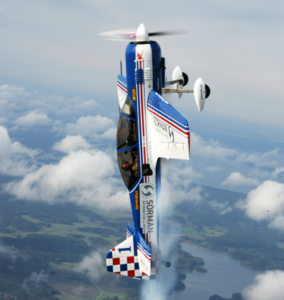Section 91.303: Aerobatic flight.

photo: Proaerobusiness.com
No person may operate an aircraft in aerobatic flight --
(a) Over any congested area of a city, town, or settlement;
(b) Over an open air assembly of persons;
(c) Within the lateral boundaries of the surface areas of Class B, Class C,
Class D, or Class E airspace designated for an airport;
(d) Within 4 nautical miles of the center line of any Federal airway;
(e) Below an altitude of 1,500 feet above the surface; or
(f) When flight visibility is less than 3 statute miles.
For the purposes of this section, aerobatic flight means an intentional maneuver involving an abrupt change in an aircraft's attitude, an abnormal attitude, or abnormal acceleration, not necessary for normal flight.
Section 91.307: Parachutes and parachuting.
a) No pilot of a civil aircraft may allow a parachute that is available for
emergency use to be carried in that aircraft unless it is an approved
type and –
1) If a chair type (canopy in back), it has been packed by a certificated and
appropriately rated parachute rigger within the preceding 120 days; or
2) If any other type, it has been packed by a certificated and appropriately
rated parachute rigger --
(i) Within the preceding 120 days, if its canopy, shrouds, and harness
are composed exclusively of nylon, rayon, or other similar synthetic
fiber or materials that are substantially resistant to damage from
mold, mildew, or other fungi and other rotting agents propagated
in a moist environment; or
(ii) Within the preceding 60 days, if any part of the parachute is
composed of silk, pongee, or other natural fiber, or materials not
specified in paragraph of this section.
- b) Except in an emergency, no pilot in command may allow, and no person may
conduct, a parachute operation from an aircraft within the United States
except in accordance with part 105 of this chapter.
- c) Unless each occupant of the aircraft is wearing an approved parachute, no
pilot of a civil aircraft carrying any person (other than a crewmember) may
execute any intentional maneuver that exceeds --
(1) A bank of 60 degrees relative to the horizon; or
(2) A nose-up or nose-down attitude of 30 degrees relative to the horizon.
- d) Paragraph (c) of this section does not apply to --
(1) Flight tests for pilot certification or rating; or
(2) Spins and other flight maneuvers required by the regulations for any
certificate or rating when given by --
(i) A certificated flight instructor; or
(ii) An airline transport pilot instructing in accordance with §61.67 of this
chapter.
- e) For the purposes of this section, approved parachute means --
(1) A parachute manufactured under a type certificate or a technical standard
order (C-23 series); or
(2) A personnel-carrying military parachute identified by an NAF, AAF, or AN
drawing number, an AAF order number, or any other military designation
or specification number.












































































































































































































